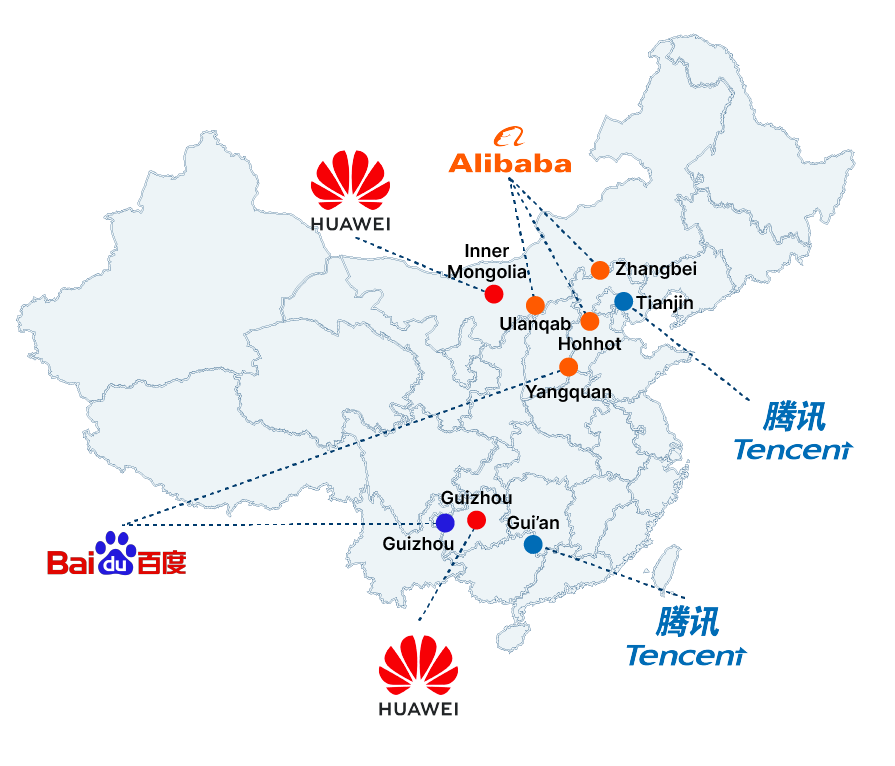In most countries, cloud regions grow where the market finds cheap land, fast internet, and steady power. In China, it works differently. It is being drawn by policy. The government has a national program, called Eastern Data, Western Computing, that decides where the cloud should grow, shifting data centers inland, away from crowded eastern cities.
A Cloud Map Redrawn by the State
In early 2022, China launched the Eastern Data, Western Computing (EDWC) initiative, a strategic plan to relocate data processing from the eastern coastal regions to the western provinces. This move aims to alleviate energy pressures in the east and harness the abundant renewable energy resources in the west.
The National Development and Reform Commission (NDRC) outlined this shift as a means to optimize the allocation of national computing power and promote green energy utilization in western regions.
The plan designates eight national computing hubs in provinces such as Guizhou, Inner Mongolia, Gansu, Ningxia, and Qinghai. These hubs are intended to serve as central nodes for data processing, supporting the digital infrastructure needs of the eastern economic centers. According to Huawei, the initiative integrates data centers, cloud computing, and big data to create a new computing network system.
China’s EDWC Hubs
.png)
As of August 2024, China has invested approximately USD 6.1 billion in the EDWC project, with total investments exceeding 200 billion yuan (~USD 28 billion), including private sector contributions. The initiative has led to the installation of 1.95 million server racks, with 63% currently in use. These developments underscore China's commitment to constructing a "digital China" and enhancing its computing capabilities.
EDWC Investment Snapshot:
.png)
A notable example of this initiative is the operation of Apple's iCloud services in mainland China. To comply with Chinese regulations, iCloud services are operated by AIPO Cloud (Guizhou) Technology Co., Ltd (GCBD), a local partner. This arrangement ensures that all data stored with iCloud, including photos, videos, documents, and backups, is subject to the terms and conditions of iCloud operated by GCBD.
The EDWC initiative reflects China's strategic approach to cloud computing, where infrastructure development is closely aligned with national policy objectives. By directing the growth of data centers to inland regions, China aims to balance regional development, optimize energy use, and strengthen its digital economy.
Guizhou: China’s Data Backbone in the West
Guizhou Province stands as a cornerstone of China's EDWC strategy. Designated as the nation's first Big Data Comprehensive Pilot Zone in 2014, Guizhou has transformed from a historically underdeveloped region into a leading hub for data infrastructure.
The Gui'an New Area, a key development zone within Guizhou, hosts numerous state-of-the-art data centers. These facilities are designed to leverage the region's abundant renewable energy resources, ensuring sustainable operations.
For instance, the Tencent Gui'an Qixing Center is renowned for its innovative design, incorporating natural mountain caves to house data servers, blending seamlessly with the surrounding landscape.
Guizhou's strategic importance is further underscored by its role in hosting major tech companies' data operations. Apple, in compliance with Chinese regulations, operates its iCloud services in mainland China through a partnership with Guizhou-Cloud Big Data Industry Development Co., Ltd. (GCBD). This collaboration ensures that all iCloud data for Chinese users is stored domestically, adhering to local data sovereignty laws.
The province's commitment to becoming a leader in intelligent computing is evident in its infrastructure investments. As of September 2025, Guizhou showcases 49 key data centers, with a total computing power reaching 92.6 exaflops, of which nearly 97% is dedicated to intelligent computing.
Guizhou's evolution into a data powerhouse exemplifies China's strategic approach to balancing technological advancement with regional development. The province's success in implementing the EDWC initiative highlights the potential of coordinated policy and investment in fostering innovation and economic growth in less-developed areas.
Law, Rules and Cloud Places: Why Geography Isn’t Just About Power & Land?
China’s cloud regions are not only shaped by where power is cheap or where land is available, but also by the country’s legal framework. The rules that govern data in China decide not just how companies operate, but where their servers must be built.
The Personal Information Protection Law (PIPL), which came into effect in 2021, is one of the toughest privacy laws in the world. It requires companies handling Chinese citizens’ data to store it inside the country. Sending data overseas is only possible with a government green light, after security reviews or special contracts are approved. This means that even global platforms cannot freely shift workloads across borders, locking China’s cloud firmly within national boundaries.
Layered on top of this is the Cybersecurity Law, which defines “critical information infrastructure,” from telecom to cloud computing, and forces operators to keep important data local. Offshore transfers face strict scrutiny, with penalties for companies that fail to comply.
Foreign cloud providers face an extra hurdle. They cannot simply set up and run their own data centers in China. Licenses for internet data centers (IDCs) and value-added telecom services can only be held by Chinese companies. As a result, firms like Microsoft, Amazon, and Apple must work with local partners who hold the permits, while they supply the technology and brand. These joint structures are tightly controlled: the local partner must be visible to the customer, and the foreign brand cannot run as the sole face of the service.
Together, these laws make geography a function of regulation as much as economics. Data cannot just follow the cheapest land or fastest cable; it must also follow the map laid out by policymakers. This is why the EDWC hubs are more than infrastructure; they are legal and political necessities as much as they are technical ones.
China’s Cloud Giants: Building Regions from the Inside
China’s cloud landscape is led first and foremost by local giants, Alibaba Cloud, Tencent Cloud, Huawei Cloud, and Baidu, and their strategies shape where new regions and hubs are built. These companies don’t just run services; they also drive infrastructure investments, build inland campuses, and push AI-ready computing into the western hubs that EDWC promotes.
Together, these four firms command nearly the entire domestic market, as the chart below shows. Alibaba leads, but Huawei, Tencent, and Baidu each hold sizable ground.
Chinese Cloud Market Share
.png)
Alibaba Cloud remains the largest player in China and has been investing heavily in cloud and AI infrastructure while expanding its presence in both domestic and international markets. Alibaba shows a global footprint of availability zones and continues to invest heavily in AI tooling and chips for inference, moves that let it optimize where it places workload-heavy services.
Tencent Cloud follows with a broad regional network and heavy investment in AI infrastructure and data-center campuses (including flagship sites in Gui’an). Tencent’s strategy combines gaming and consumer cloud needs with the rapid expansion of capacity for enterprise and AI workloads, making it a major player in both Eastern and Western hubs.
Baidu has leaned into AI-first cloud offerings, using its Kunlun family of chips and large training clusters to host and train models at scale. Baidu’s moves to deploy Kunlun clusters and fold that compute into its cloud services show how an AI focus changes the kinds of regions and facilities operators build.
Huawei combines cloud services with its own Ascend chips and large “supernode” systems, pushing hardware and software together so its cloud regions are optimized for domestic silicon and high-throughput workloads. Huawei’s chip roadmap and Atlas supernode plans are driving a new wave of AI-capable deployments across China.
China's Cloud Giants: Accelerated Infrastructure Buildout (2020-2024)
Simply put, the domestic hyperscalers are not passive tenants of EDWC; they are active architects. Their competition determines which inland provinces get priority, which campuses get upgraded for AI, and how national policy (EDWC) turns into real data-centre geography on the ground.

Business and Global Implications
China’s cloud isn’t just a collection of data centers; it’s a carefully orchestrated ecosystem shaped by law, policy, and competition. For multinational companies, operating here is never as simple as building servers. Every foreign provider must work with a local partner, every license and contract must comply with Chinese regulations, and every workflow must navigate rules around data storage and cross-border transfer. This makes China unique: foreign clouds exist, but always through local management and oversight.
At the same time, EDWC is more than compliance management. It’s a tool for economic and regional development, using data centers to bring investment, jobs, and renewable energy into inland provinces. By integrating cloud growth with inland development, China is combining technology, energy strategy, and regional planning in a way few countries attempt.
Globally, this approach signals a new kind of cloud sovereignty. Unlike the United States, where cloud infrastructure grew organically around markets, or India, where expansion is driven by ambition and market forces, China’s model is state-guided and planned, with geography, policy, and sovereignty baked into every hub. It is a cloud designed by the state, where infrastructure itself becomes a strategic asset rather than just a service.
The Cloud by Design: China’s Digital Blueprint
China’s cloud story is one of deliberate design. From Guizhou’s mountains to Inner Mongolia’s plains, from Ningxia’s foreign-managed hubs to the enduring clusters near Beijing, every region tells a story of policy, planning, and strategic foresight. The Eastern Data, Western Computing initiative has turned geography into a tool, moving the country’s digital backbone inland while balancing energy, regulation, and development goals.
In doing so, China is not just building cloud services; it is building digital sovereignty, a network where every server, every campus, and every workflow aligns with national priorities. Compared with the US, where cloud grew from market demand, and India, where ambition drives expansion, China’s approach is calculated, controlled, and uniquely its own. The result is a cloud that is as much a reflection of policy as it is of technology, shaping not only the country’s digital future but also its place in the global computing landscape.




.jpg)
.jpg)